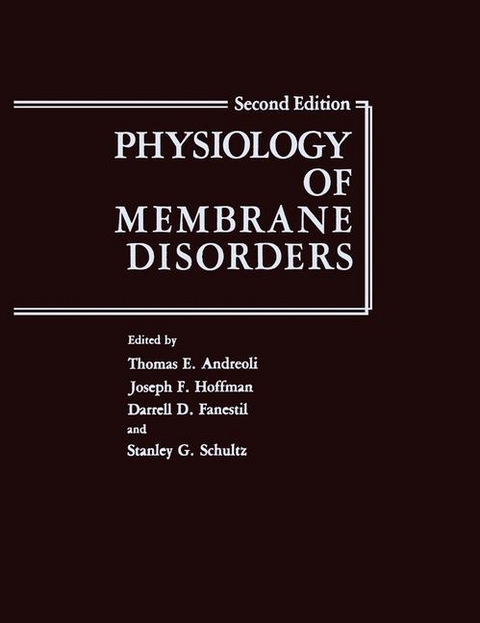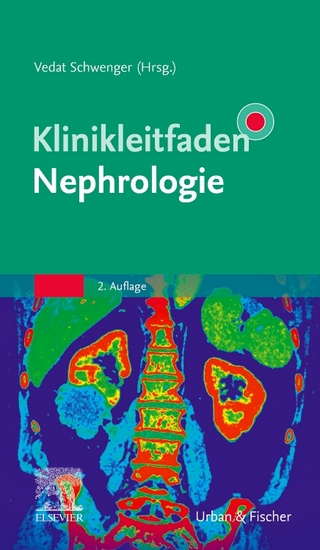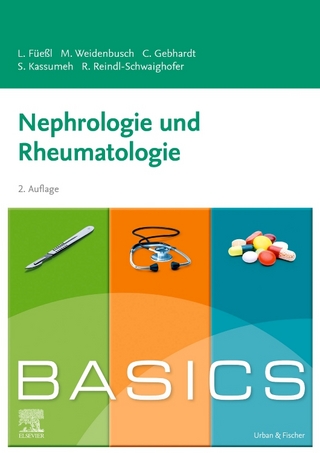
Physiology of Membrane Disorders
Kluwer Academic/Plenum Publishers (Verlag)
978-0-306-41774-0 (ISBN)
- Titel ist leider vergriffen;
keine Neuauflage - Artikel merken
I: The Nature of Biological Membranes.- 1: The Anatomy of Biological Interfaces.- 1. Introduction.- 2. Models of Membrane Structure.- 3. Membrane Junctions.- 4. Certain Specialized Membranes.- 5. Lipid-Protein Interactions in Model Membranes.- 6. Membrane Fluidity.- 7. Mechanisms of Protein-Lipid Interactions.- 8. Mueller-Rudin Bilayer Membranes.- 9. Freeze-Fracture-Etch Studies of Membranes.- 10. Summary.- References.- 2: Composition and Dynamics of Lipids in Biomembranes.- 1. Molecular Organization of Lipids in Biomembranes.- 2. Lipid Composition of Mammalian Cell Membranes.- 3. Molecular Structure of Membrane Lipids.- 4. Molecular Motions in Bilayers.- 5. Interactions between Lipids in Bilayers.- 6. Summary.- References.- 3: Membrane Proteins: Structure, Arrangement, and Disposition in the Membrane.- 1. Introduction.- 2. Protein Composition of Membranes.- 3. Types of Membrane Proteins.- 4. Extrinsic Proteins.- 5. Intrinsic Proteins.- 6. Types of Intrinsic Membrane Proteins.- 7. The Structure of the Intramembrane Portion.- 8. Disposition of Proteins in the Membrane.- 9. Summary.- References.- II: Methods for Studying Membranes.- 4: The Nature and Limitations of Electron Microscopic Methods in Biology.- 1. Introduction.- 2. The Conventional Transmission Electron Microscope.- 3. Specimen Preparation.- 4. Embedding.- 5. Sectioning.- 6. Positive Staining.- 7. Negative Staining.- 8. Low-Dose Electron Microscopy.- 9. The Freeze-Fracture-Etch (FFE) Technique.- 10. Summary.- References.- 5: Isolation and Characterization of Biological Membranes.- 1. Introduction.- 2. Methods for Dissociating and Separating Cells.- 3. Isolation of Plasma Membranes.- 4. Assessment of Purification.- 5. Expression of Data.- 6. Functional Properties of Plasma Membranes.- 7. Pathological Considerations.- 8. Summary.- References.- 6: Absorption and Optical Rotation Spectra of Biological Membranes: Distortions and Their Corrections.- 1. Introduction.- 2. Distortions and Corrections for Suspensions.- 3. Purple Membrane as a Sample Calculation.- 4. Summary.- References.- 7: Mathematical Models of Membrane Transport Processes.- 1. Introduction.- 2. Diffusion.- 3. Osmosis.- 4. Ionic Diffusion.- 5. Facilitated Diffusion.- 6. Single-File Diffusion.- 7. Summary.- References.- 8: Application of Tracers to the Study of Membrane Transport Processes.- 1. Introduction.- 2. Tracers and Problems in the Use of Tracers.- 3. Isotope Effects.- 4. Rate Processes.- 5. Compartmental Systems and Compartmental Analysis.- 6. Theoretical Foundations for the Use of Tracers to Measure Rates.- 7. Applications to the Study of Membrane Transports.- 8. Summary.- References.- 9: Principles of Electrical Methods for Studying Membrane Movements of Ions.- 1. Introduction.- 2. Steady-State Characteristics of Biological Membranes.- 3. Non-Steady-State Electrical Properties of Membranes.- 4. Fluctuation Analysis of Electrical Properties of Membranes.- 5. Single-Channel Studies.- 6. Summary.- 7. Appendix.- References.- 10: The Study of Transport and Enzymatic Processes in Reconstituted Biological Systems.- 1. Introduction.- 2. Energy-Linked Processes.- 3. Receptors and Channels.- 4. Passive Transport System.- 5. Summary.- References.- III: General Problems in Membrane Biology.- 11: Principles of Water and Nonelectrolyte Transport across Membranes.- 1. Introduction.- 2. Diffusion as a Permeation Mechanism.- 3. Activation Energy for Diffusion: Measurement and Significance.- 4. Convection.- 5. Osmosis.- 6. Water and Nonelectrolyte Membrane Permeation Mechanisms.- 7. Summary.- References.- 12: Anion Transport in Erythrocytes.- 1. Introduction.- 2. Modes of Anion Transport.- 3. Anion Exchange in Human Erythrocytes.- 4. Net Anion Transport in Red Blood Cells.- 5. Cation-Coupled Anion Transport.- 6. Anion Transport in Other Single Cells.- 7. Relationship of Red Cell Anion Transport to Other Transport Systems.- 8. Summary.- References.- 13: Active Transport of Na+ and K+ by Red Blood Cells.- 1. Introduction.- 2. Intracellular Solutes and Water.- 3. Donnan and “Double Donnan” Equilibrium.- 4. Membrane Potential.- 5. Active Transport.- 6. Properties of the Na+,K+ Pump.- 7. Transport Modes of the Na+,K+ Pump.- 8. Ion Selectivity of the Na+,K+ Pump.- 9. Ouabain and the Na+,K+ Pump.- 10. Molecular Mechanism of the Na +,K + Pump.- References.- 14: Weak Electrolyte Transport across Biological Membranes: General Principles.- 1. Introduction.- 2. Weak Electrolyte Diffusion.- 3. Complex Mechanisms.- 4. Summary.- References.- 15: Ion Permeation in Cell Membranes.- 1. Introduction.- 2. How Ion Permeation Is Studied.- 3. Deviations from Independence.- 4. Gramicidin.- 5. Acetylcholine Receptor Channel.- 6. Voltage-Gated Sodium Channel.- 7. Potassium Channels.- 8. Calcium Channels.- 9. Summary.- References.- 16: Processing and Sorting of Proteins Synthesized in the Endoplasmic Reticulum.- 1. Introduction.- 2. Cotranslational Processing of Proteins.- 3. Posttranslational Processing of Proteins.- 4. Regulation of Protein Sorting and Membrane Interactions.- 5. Summary.- References.- 17: Ion-Coupled Transport of Organic Solutes across Biological Membranes.- 1. Introduction.- 2. Sodium-Coupled Sugar and Amino Acid Transport by Small Intestine and Renal Proximal Tubule.- 3. Proton-Coupled Galactoside Transport by E. coli.- 4. Toward a Mechanicokinetic Model of Ion-Coupled Nonelectrolyte Transport.- 5. Conclusions.- References.- 18: Bioenergetics of Membrane Transport Processes.- 1. Introduction.- 2. The Control of Mitochondrial Respiration.- 3. Thermogenesis.- 4. Respiration and Active Plasma Membrane Transport in Intact Cells.- 5. Summary.- References.- 19: Regulation of Cellular Volume.- 1. Introduction.- 2. Historical Perspective.- 3. The Gibbs-Donnan Equilibrium.- 4. The “Double Donnan” Hypothesis and Cellular Volume Regulation.- 5. Estimates of Cellular Colloid Osmotic Pressure.- 6. The Specificity of Cellular Sodium Chloride in Cellular Volume Regulation.- 7. Consequences of Metabolic Inhibition.- 8. Plasma Membrane Permeability and Cellular Volume.- 9. Regulation of Cellular Volume in Media Containing Cardiac Glycosides.- 10. Cellular Volume Regulation by Means Other Than the Cardiac Glycoside-Sensitive Na +, K + -ATPase.- 11. The Regulation of Volume in Cells Exposed to Anisosmotic Media.- 12. Summary and Conclusions.- References.- 20: Cell-to-Cell Communication: Permeability, Regulation, Formation, and Functions of the Cell-Cell Membrane Channel in Cell Junctions.- 1. Introduction.- 2. The Cell-to-Cell Membrane Channel.- 3. Regulation of the Cell-to-Cell Channel.- 4. Channel Formation.- 5. Physiological Roles of the Cell-to-Cell Channels.- References.- 21: Genes and Membranes.- 1. Introduction.- 2. Genetic Methods.- 3. Criteria for Establishing That Differences in Membrane Properties Are Genetically Determined.- 4. Information That Can Be Gained from Biochemical and Physiological Studies on Transport Mutants and from Cloning Studies.- 5. Information That Can Be Gained from Genetic Analysis.- 6. Summary.- References.- 22: The Interaction of Hormones with Biological Membranes.- 1. Introduction.- 2. Hormone Interaction with Receptor.- 3. Subunit Composition of Membrane Receptors.- 4. Transduction of Response to Interaction of Hormone and Receptor.- 5. Fate of Hormone-Receptor Complex.- 6. Down-Regulation of Surface Membrane Content of Receptors.- 7. Interactions between Receptors for Different Hormones.- 8. Summary.- References.- 23: Modification of Membrane Function by Drugs.- 1. Introduction.- 2. Drugs Affecting Transport Mechanisms of the Plasma Membrane.- 3. Drugs Affecting Excitation Phenomena.- 4. Drugs Affecting Coupling Mechanisms of Membranes.- 5. Summary.- References.- IV: Transport Events in Single Cells.- 24: Active Transport in Escherichia Coli: From Membrane to Molecule.- 1. Introduction.- 2. Membrane Vesicles and Active Transport: General Aspects.- 3. Energetics of Active Transport.- 4. Active Transport at the Molecular Level: The p-Galactoside Transport System.- 5. Summary.- References.- 25: Acidification of Intracellular Organelles: Mechanism and Function.- 1. Introduction.- 2. Evidence for Acid Interior.- 3. Generation of ?pH.- 4. Uses of ?pH.- 5. The Nature of the ATPase.- 6. Conclusion.- References.- 26: Intracellular pH Regulation.- 1. Introduction.- 2. Measurement of Intracellular pH.- 3. Cellular Buffering Processes.- 4. Effect of Externally Applied Weak Acids and Bases.- 5. Ion-Transport Systems.- References.- 27: Properties of Ionic Channels in Excitable Membranes.- 1. Introduction.- 2. How Do You Get a Resting Potential?.- 3. How Do You Change the Membrane Potential?.- 4. Ionic Channels.- 5. The Two-State Model.- 6. Real Channels Have More Than Two States.- 7. Na+ Channels.- 8. K+ Channels.- 9. Summary.- References.- 28: Ion Movements in Skeletal Muscle in Relation to the Activation of Contraction.- 1. Introduction.- 2. The Ultrastructure of the Tubular System in Skeletal Muscle Fibers.- 3. Electrical Properties of the Surface and Tubular Membrane.- 4. Inward Spread of Excitation.- 5. Cellular Ca2+ Movements Related to the Activation of Contraction.- 6. Summary.- References.- 29: Excitable Tissues: The Heart.- 1. Introduction.- 2. Multicellular Structure of the Heart.- 3. Electrical Activity in Different Regions of the Heart.- 4. Na + Channels and Excitability.- 5. Ca2+ Channels and Slow Responses.- 6. K+ Channels Support the Resting Potential and Action Potential Repolarization.- 7. Inward Currents and Pacemaker Activity.- 8. Adrenergic and Cholinergic Modulation of Cardiac Activity.- 9. Summary.- References.- 30: Ion Transport through Ligand-Gated Channels.- 1. Introduction and Overview.- 2. Structure of the Nicotinic AChR.- 3. Immunological Approaches to the Study of the Nicotinic AChR.- 4. Biogenesis, Membrane Localization, and Regulation.- 5. Dose-Response.- 6. Kinetics of Channel Gating.- 7. AChR Cation Selectivity and Permeation.- 8. Ligand-Gated Channels Other Than the AChR.- 9. An Emerging View of Transmitter-Activated Channels.- References.- V: Transport in Epithelia: Vectorial Transport through Parallel Arrays.- 31: Cellular Models of Epithelial Ion Transport.- 1. Introduction.- 2. Models of Sodium- and Chloride-Absorbing Epithelial Cells.- 3. A Model for Active Chloride Secretion by Epithelial Cells.- 4. Summary.- References.- 32: Ion Transport by Gastric Mucosa.- 1. Introduction.- 2. Organization of Gastric Epithelial Cells.- 3. Stimulus-Secretion Coupling in Oxyntic Cells.- 4. Metabolism and Energetics Associated with Gastric HC1 Secretion.- 5. Studies with Isolated Cell Fractions and Membranes.- 6. Electrophysiological and Tracer Flux Studies of Gastric Ion Transport.- 7. Summary.- References.- 33: Ion and Water Transport in the Intestine.- 1. Introduction.- 2. Models of Intestinal Na+, CI-, and H20 Transport.- 3. Intestinal Na + and Cl- Absorption.- 4. Intestinal Na+ and Cl- Secretion.- 5. HC03-, Short-Chain Fatty Acid, and K+ Transport.- 6. Shunt Pathway and Water Transport.- 7. Control of Intestinal Electrolyte Transport.- 8. Summary and Conclusions.- References.- 34: The Uptake of Lipids into the Intestinal Mucosa.- 1. Introduction.- 2. Chemical Species of Lipids That Are Involved during Fat Absorption.- 3. The Barriers to Lipid Absorption in the Intestine.- 4. Characteristics of the Intestinal Microvillus Membrane Barrier to Lipid Absorption.- 5. Characteristics of the Intestinal Unstirred Water Layer Barrier to Lipid Absorption.- 6. Characteristics of Fatty Acid and Cholesterol Absorption in the Intestine.- 7. Role of Bile Acid Micelles in Facilitating Lipid Absorption in the Intestine.- 8. Nonpolar Lipids.- 9. Summary Description of the Process of Lipid Uptake.- References.- 35: Mechanisms of Bile Secretion and Hepatic Transport.- 1. Introduction.- 2. Structural Determinants of Bile Secretory Function.- 3. Mechanisms of Hepatocellular Water and Electrolyte Secretion.- 4. Other Primary Driving Forces for Canalicular Bile Secretion (Bile Acid- Independent Secretion).- 5. Model for Hepatocyte Water and Electrolyte Secretion.- 6. Physiological Modifiers of Hepatocyte Bile Formation.- 7. Organic Anion Solute Transport.- 8. Lipid Excretion in Bile.- 9. Proteins in Bile.- 10. Miscellaneous Substances Found in Bile.- 11. Bile Duct Function.- 12. Summary.- References.- 36: The Regulation of Glomerular Filtration Rate in Mammalian Kidneys.- 1. Introduction.- 2. Ultrastructural Considerations.- 3. Characteristics of the Filtration Process.- 4. Quantitative Description of Glomerular Dynamics.- 5. Physiological Regulation of Glomerular Filtration Rate.- 6. Intrarenal Distribution of Glomerular Filtration Rate.- 7. Summary.- References.- 37: The Proximal Nephron.- 1. General Properties of the Proximal Nephron.- 2. Distribution of Transport Functions along the Proximal Tubule.- 3. Transepithelial Potentials and Passive Permeabilities.- 4. NaCl and NaHC03 Transport.- 5. Solute-Solvent Coupling—Role of the Intercellular Shunt Pathway.- References.- 38: The Effects of ADH on Salt and Water Transport in the Mammalian Nephron: The Collecting Duct and Thick Ascending Limb of Henle.- 1. Introduction.- 2. Intracellular Mediators of ADH Action.- 3. The Medullary Thick Ascending Limb.- 4. The Collecting Tubule.- 5. Homology of Hormone Action.- 6. Modulation of the ADH Response.- 7. Summary: Integration of ADH Action on Urinary Concentration.- References.- 39: Urinary Concentrating and Diluting Processes.- 1. Introduction.- 2. Renal Structure.- 3. Basic Concepts.- 4. Handling of Individual Solutes in the Medulla.- 5. Properties of the Thin Limbs of Henle’s Loops.- 6. Concentration in the Inner Medulla.- 7. Summary.- References.- 40: Transport Functions of the Distal Convoluted Tubule.- 1. Introduction.- 2. Structural Heterogeneity.- 3. Transepithelial Net Transport of Solutes and Water.- 4. Electrophysiological Considerations.- 5. Mechanisms of Transport.- 6. Summary.- References.- 41: The Respiratory Epithelium.- 1. Introduction.- 2. The Tracheal Epithelium.- 3. The Bronchial Epithelium.- 4. The Alveolar Epithelium.- 5. The Fetal Lung.- 6. Summary.- References.- VI: Clinical Disorders of Membrane Transport Processes.- 42: The Cellular Basis of Ischemic Acute Renal Failure.- 1. Introduction.- 2. Ischemic Injury.- 3. Summary.- References.- 43: Genetic Variants Affecting the Structure and Function of the Human Red Cell Membrane.- 1. Introduction.- 2. Intrinsic Membrane Abnormalities.- 3. Hemoglobinopathies.- 4. Endocrine Disorders.- 5. Manic-Depressive Disease.- 6. Essential Hypertension.- 7. Inherited Neuromuscular Disorders.- 8. Adenosine Deaminase Variants.- References.- 44: Inherited Membrane Disorders of Muscle: Duchenne Muscular Dystrophy and Myotonic Muscular Dystrophy.- 1. Introduction.- 2. Myotonic Muscular Dystrophy.- 3. Duchenne Muscular Dystrophy.- 4. Summary.- References.- 45: Disorders of Muscle: The Periodic Paralyses.- 1. Introduction.- 2. Clinical Features.- 3. Pathophysiology of the Periodic Paralysis.- 4. Therapy and Its Rationale.- 5. Summary.- References.- 46: Pathophysiology of Cardiac Arrhythmias.- 1. Introduction.- 2. Abnormalities of Impulse Propagation.- 3. Interactions between Abnormal Impulse Formation and Propagation.- 4. Electrophysiological Mechanisms Responsible for Clinically Occurring Arrhythmias.- 5. Summary.- References.- 47: Pathophysiology of Peptic Ulcer Disease.- 1. Introduction.- 2. Gastric vs. Duodenal Ulcer.- 3. Acid-Pepsin Secretion.- 4. Mucosal Resistance.- 5. Conclusions.- References.- 48: Malabsorption Syndromes.- 1. Introduction.- 2. Lipid Digestion and Absorption.- 3. Normal Enterohepatic Circulation of Bile Acids.- 4. Carbohydrate and Protein Digestion and Absorption.- 5. Tests of Intestinal Digestive and Absorptive Function.- 6. Diseases Affecting Normal Digestion or Absorption.- 7. Summary.- References.- 49: Pathophysiology of Calcium Absorptive Disorders.- 1. Introduction.- 2. Regulation of Intestinal Calcium Absorption.- 3. Sites of Calcium Absorption.- 4. Mechanism of Calcium Absorption.- 5. The Role of Vitamin D.- 6. Clinical Disorders Associated with Alterations in Calcium Absorption.- 7. Increased Absorption of Calcium.- 8. Malabsorption of Calcium.- 9. Drug-Induced Inhibition of Calcium Absorption.- 10. Nutritional Factors.- References.- 50: Cystic Fibrosis.- 1. Introduction.- 2. Clinical Features.- 3. Prognosis.- 4. Genetics.- 5. Pathogenesis.- 6. Animal Models.- 7. Commentary.- 8. Summary.- References.- 51: Disorders of Glomerular Filtration.- 1. Introduction.- 2. Some General Truths.- 3. Some General Observations on the Mechanism of Change in GFR in the Physiologic Setting.- 4. Potential Interactions among the Determinants of Glomerular Ultrafiltration.- 5. The Influence of Humoral and Hormonal Substances upon Glomerular Ultrafiltration.- 6. Angiotensin II.- 7. The Adrenergic Nervous System.- 8. ADH, cAMP.- 9. Prostaglandins, Thromboxanes, Kinins.- 10. PTH, Ca2+.- 11. Papaverine, Acetylcholine, Histamine, Methylprednisolone.- 12. The Final Common Pathway Viewpoint.- 13. Glomerular Ultrafiltration in Altered Physiologic States.- 14. Influences of Tubuloglomerular Feedback System on the Process of Glomerular Filtration.- 15. Pathophysiologic Conditions.- 16. Glomerular Immune Injury.- 17. Glomerular Effects of Systemic Hypertension.- 18. Isolated Glomeruli in Vitro.- 19. Causes of Progressive Reduction in GFR.- 20. Summary.- References.- 52: The Hypertonic and Hypotonic Syndromes.- 1. Introduction.- 2. Antidiuretic Hormone.- 3. Thirst.- 4. The Hypertonic Syndromes.- 5. The Hypotonie Syndromes.- 6. Summary.- References.- 53: Disorders of Proton Secretion by the Kidney.- 1. Introduction.- 2. Proton Transport across Urinary Epithelia.- 3. Functional Organization of H+ Secretion in the Kidney.- 4. The Renal Acidoses.- 5. Reduced Nephron Population.- 6. Renal Hypoperfusion.- 7. Renal Tubular Acidosis.- 8. Proximal Renal Tubular Acidosis.- 9. Distal Renal Tubular Acidosis.- 10. Impaired Excretion of Net Acid and Potassium (Normal pH Gradient Formation).- 11. Clinical Aspects of Renal Tubular Acidosis and Associated Disorders of Electrolyte Transport.- 12. Summary.- References.- 54: Cystinosis and the Fanconi Syndrome.- 1. Introduction.- 2. Historical Resume.- 3. Clinical and Pathological Features.- 4. Chemistry and Metabolism of Cystine.- 5. Other Causes of the Fanconi Syndrome.- 6. Treatment.- 7. Summary.- References.- 55: Renal Tubular Defects in Phosphate and Amino Acid Transport.- 1. Introduction.- 2. Defects in Phosphate Transport Processes.- 3. Aminoacidurias.- 4. Summary.- References.- 56: Pulmonary Edema.- 1. Introduction.- 2. Starling Force Analysis.- 3. Safety Factors Associated with Hydrostatic Edemas.- 4. Safety Factors Associated with Noncardiac Edema.- 5. Mechanisms of Intraalveolar Edema Formation.- 6. Summary.- References.
| Erscheint lt. Verlag | 31.1.1986 |
|---|---|
| Zusatzinfo | 383 Illustrations, black and white; 1094 p. 383 illus. |
| Verlagsort | New York |
| Sprache | englisch |
| Gewicht | 2780 g |
| Themenwelt | Medizinische Fachgebiete ► Innere Medizin ► Nephrologie |
| ISBN-10 | 0-306-41774-X / 030641774X |
| ISBN-13 | 978-0-306-41774-0 / 9780306417740 |
| Zustand | Neuware |
| Haben Sie eine Frage zum Produkt? |
aus dem Bereich


